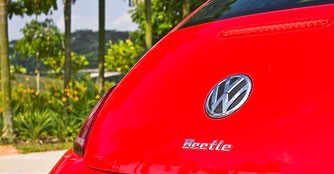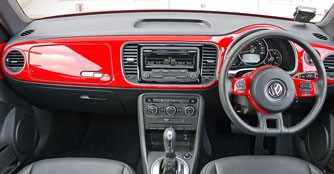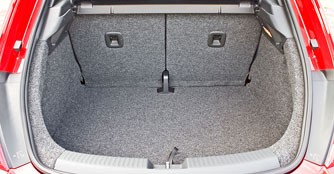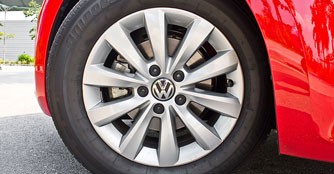Volkswagen Beetle 1.2 TSI (A) Review
03 Sep 2012|21,710 views
Throughout its vast history, the Beetle has embodied Volkswagen's 'people's car' philosophy, with the Type 1 (also called the Bug) becoming over 21 million people's car before its production was ceased. The New Beetle, introduced in 98, drew heavy inspiration from the design of the Type 1 and, as a result, had a long and successful 12-year term amongst, by and large, female.
But unlike the original Type 1, the New Beetle was a front engined front-wheel-drive configuration, with luggage storage in the rear. But it was really no shame in the car's new layout, considering the positively strong public reaction to the car. You see, the New Beetle was one of those cars that started the retro-futurist design trend (the other is of course the MINI). It was a modernised version of the legendary Beetle that struck a chord with consumers who had grown tired of conservative car designs and had fond memories of the car from the popular culture.
Now, the successor to the New Beetle has arrived and VW has redesigned its popular classic once more and has unveiled it as the Volkswagen Beetle.
Exterior
This latest iteration of the Beetle strives to be less feminine than its predecessor, focusing on appealing to more than just people who can get away with wearing skirts in public. As a result, VW has done without the large bubble appearance of the Beetle, replacing it with a more masculine design that's lower, tauter and slightly longer.
To be exact, the VW Beetle sits at 4278mm x 1808mm x 1486mm (L x W x H). Its length and width have increased by 152mm and 84mm respectively but its roofline has been lowered by 12mm. It does make for a much sportier and sleeker appearance compared with the model that preceded it.
But unlike the original Type 1, the New Beetle was a front engined front-wheel-drive configuration, with luggage storage in the rear. But it was really no shame in the car's new layout, considering the positively strong public reaction to the car. You see, the New Beetle was one of those cars that started the retro-futurist design trend (the other is of course the MINI). It was a modernised version of the legendary Beetle that struck a chord with consumers who had grown tired of conservative car designs and had fond memories of the car from the popular culture.
Now, the successor to the New Beetle has arrived and VW has redesigned its popular classic once more and has unveiled it as the Volkswagen Beetle.
Exterior
This latest iteration of the Beetle strives to be less feminine than its predecessor, focusing on appealing to more than just people who can get away with wearing skirts in public. As a result, VW has done without the large bubble appearance of the Beetle, replacing it with a more masculine design that's lower, tauter and slightly longer.
To be exact, the VW Beetle sits at 4278mm x 1808mm x 1486mm (L x W x H). Its length and width have increased by 152mm and 84mm respectively but its roofline has been lowered by 12mm. It does make for a much sportier and sleeker appearance compared with the model that preceded it.
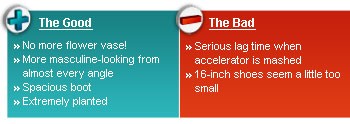 |
Good thing is - despite the necessary changes that were implemented, the modern classic you see here hasn't lost its trademark appearance. The swollen fenders and bug-eyed headlamps are all still intact.
It does take more than a keen eye to spot the changes in its dimensions, considering we couldn't tell the difference when we picked up the car. The only giveaway for us was the 'Beetle' word under the emblem at back, giving it the extra 'shout out'.
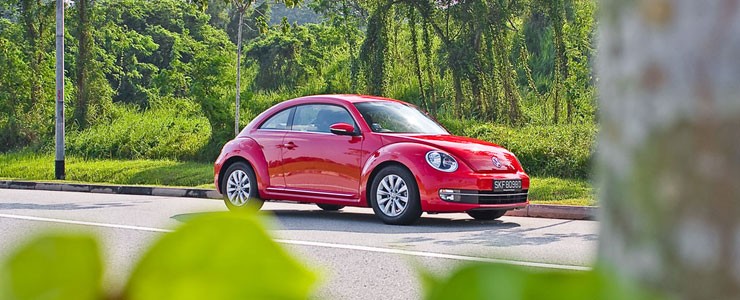 |
Interior
As with the exterior design, gender-neutral features carry on to the inside of the car. For starters, VW got rid of the flower vase. In our opinion, it works perfectly well if the car is trying to welcome more male buyers. The other feature that's more power than flower is the optional Fender premium sound system. According to VW, customers who choose this sound system will also get interior ambience lighting that can be set to one of 3 colours (white, red and blue).
What are also attractive are the painted dash and door panels that match the colour of the exterior. Not only is it a utilitarian touch to enhance the youthfulness of the car, the fact that it creates a cheerful cabin doesn't harm too. And while cabin materials aren't as premium as some of the higher-end models in VW's stable, attention to detail results in a rather high-grade interior we've come to expect from the German marque.
As with the exterior design, gender-neutral features carry on to the inside of the car. For starters, VW got rid of the flower vase. In our opinion, it works perfectly well if the car is trying to welcome more male buyers. The other feature that's more power than flower is the optional Fender premium sound system. According to VW, customers who choose this sound system will also get interior ambience lighting that can be set to one of 3 colours (white, red and blue).
What are also attractive are the painted dash and door panels that match the colour of the exterior. Not only is it a utilitarian touch to enhance the youthfulness of the car, the fact that it creates a cheerful cabin doesn't harm too. And while cabin materials aren't as premium as some of the higher-end models in VW's stable, attention to detail results in a rather high-grade interior we've come to expect from the German marque.
A quartet of adults can comfortably ride in the Beetle, even for the two adults at the back, thanks to the increased wheelbase of 2,537mm. In front, there's much to love about the Beetle. The thinner-than-usual steering wheel is a rather classic piece, reminding you of the original Beetle while driving position feels a little more upright and sporty, with a clear view in almost every direction.
More notably, boot space is now an impressive 310 litres - up from its previous 209 litres. Knock the benches down and the whopping 905 litres should see to more than just your picnic Sundays.
More notably, boot space is now an impressive 310 litres - up from its previous 209 litres. Knock the benches down and the whopping 905 litres should see to more than just your picnic Sundays.
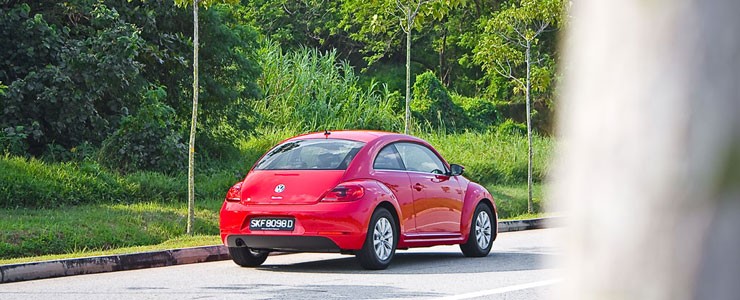 |
The Drive
The humble 1.2-litre TSI powerplant underneath its curved bonnet delivers a familiar surge of power - a total of 105bhp to be exact. Coupled with the unobtrusive DSG's immediate upshifts and rev-matched downshifts, the Beetle finishes the century sprint in just under 11 seconds. While this may not seem impressive enough to write home about, it does feel much faster in real life driving conditions, thanks to the 175Nm of torque that's available from just 1,550rpm.
It's also extremely enjoyable to have this car thrown into corners. Credit goes to the increase in the Beetle's track widths of 63mm and 49mm for the front and rear respectively, giving the car a planted stance to hustle the corners with confidence. More importantly, it's a decent handler, with its understeering characteristics kept well in check until you decide to go beyond reasonable cornering speeds.
The suspension is firm but never uncomfortable, making the eye candy of a car completely docile around town and rides smoothly over broken and rough roads with ease. This is also due to the fact that our test car came with a set of puny 16-inchers.
The humble 1.2-litre TSI powerplant underneath its curved bonnet delivers a familiar surge of power - a total of 105bhp to be exact. Coupled with the unobtrusive DSG's immediate upshifts and rev-matched downshifts, the Beetle finishes the century sprint in just under 11 seconds. While this may not seem impressive enough to write home about, it does feel much faster in real life driving conditions, thanks to the 175Nm of torque that's available from just 1,550rpm.
It's also extremely enjoyable to have this car thrown into corners. Credit goes to the increase in the Beetle's track widths of 63mm and 49mm for the front and rear respectively, giving the car a planted stance to hustle the corners with confidence. More importantly, it's a decent handler, with its understeering characteristics kept well in check until you decide to go beyond reasonable cornering speeds.
The suspension is firm but never uncomfortable, making the eye candy of a car completely docile around town and rides smoothly over broken and rough roads with ease. This is also due to the fact that our test car came with a set of puny 16-inchers.
Perhaps the only complain was the lag time we encountered when we dug deep into the throttle. It does make for some unnecessarily anxious moments when attempting to overtake slower vehicles on the highway.
Conclusion
Volkswagen made buyers of the original Beetle realise that it was fun and cool to be the little one. Thus, the car was a hip and economical ride that made a huge statement and that perception has been and always will remain true to the 1960s pop culture.
Now, in the era of small is the new big, the Beetle is like a love child of a hippy chick and a dashing young man, attracting the eyes of the youth (or even the young at heart). Best of all, the design doesn't just appeal to the fairer sex anymore.
I guess it's really the little things that count.
Conclusion
Volkswagen made buyers of the original Beetle realise that it was fun and cool to be the little one. Thus, the car was a hip and economical ride that made a huge statement and that perception has been and always will remain true to the 1960s pop culture.
Now, in the era of small is the new big, the Beetle is like a love child of a hippy chick and a dashing young man, attracting the eyes of the youth (or even the young at heart). Best of all, the design doesn't just appeal to the fairer sex anymore.
I guess it's really the little things that count.
Throughout its vast history, the Beetle has embodied Volkswagen's 'people's car' philosophy, with the Type 1 (also called the Bug) becoming over 21 million people's car before its production was ceased. The New Beetle, introduced in 98, drew heavy inspiration from the design of the Type 1 and, as a result, had a long and successful 12-year term amongst, by and large, female.
But unlike the original Type 1, the New Beetle was a front engined front-wheel-drive configuration, with luggage storage in the rear. But it was really no shame in the car's new layout, considering the positively strong public reaction to the car. You see, the New Beetle was one of those cars that started the retro-futurist design trend (the other is of course the MINI). It was a modernised version of the legendary Beetle that struck a chord with consumers who had grown tired of conservative car designs and had fond memories of the car from the popular culture.
Now, the successor to the New Beetle has arrived and VW has redesigned its popular classic once more and has unveiled it as the Volkswagen Beetle.
Exterior
This latest iteration of the Beetle strives to be less feminine than its predecessor, focusing on appealing to more than just people who can get away with wearing skirts in public. As a result, VW has done without the large bubble appearance of the Beetle, replacing it with a more masculine design that's lower, tauter and slightly longer.
To be exact, the VW Beetle sits at 4278mm x 1808mm x 1486mm (L x W x H). Its length and width have increased by 152mm and 84mm respectively but its roofline has been lowered by 12mm. It does make for a much sportier and sleeker appearance compared with the model that preceded it.
But unlike the original Type 1, the New Beetle was a front engined front-wheel-drive configuration, with luggage storage in the rear. But it was really no shame in the car's new layout, considering the positively strong public reaction to the car. You see, the New Beetle was one of those cars that started the retro-futurist design trend (the other is of course the MINI). It was a modernised version of the legendary Beetle that struck a chord with consumers who had grown tired of conservative car designs and had fond memories of the car from the popular culture.
Now, the successor to the New Beetle has arrived and VW has redesigned its popular classic once more and has unveiled it as the Volkswagen Beetle.
Exterior
This latest iteration of the Beetle strives to be less feminine than its predecessor, focusing on appealing to more than just people who can get away with wearing skirts in public. As a result, VW has done without the large bubble appearance of the Beetle, replacing it with a more masculine design that's lower, tauter and slightly longer.
To be exact, the VW Beetle sits at 4278mm x 1808mm x 1486mm (L x W x H). Its length and width have increased by 152mm and 84mm respectively but its roofline has been lowered by 12mm. It does make for a much sportier and sleeker appearance compared with the model that preceded it.
Good thing is - despite the necessary changes that were implemented, the modern classic you see here hasn't lost its trademark appearance. The swollen fenders and bug-eyed headlamps are all still intact.
It does take more than a keen eye to spot the changes in its dimensions, considering we couldn't tell the difference when we picked up the car. The only giveaway for us was the 'Beetle' word under the emblem at back, giving it the extra 'shout out'.
It does take more than a keen eye to spot the changes in its dimensions, considering we couldn't tell the difference when we picked up the car. The only giveaway for us was the 'Beetle' word under the emblem at back, giving it the extra 'shout out'.
Interior
As with the exterior design, gender-neutral features carry on to the inside of the car. For starters, VW got rid of the flower vase. In our opinion, it works perfectly well if the car is trying to welcome more male buyers. The other feature that's more power than flower is the optional Fender premium sound system. According to VW, customers who choose this sound system will also get interior ambience lighting that can be set to one of 3 colours (white, red and blue).
What are also attractive are the painted dash and door panels that match the colour of the exterior. Not only is it a utilitarian touch to enhance the youthfulness of the car, the fact that it creates a cheerful cabin doesn't harm too. And while cabin materials aren't as premium as some of the higher-end models in VW's stable, attention to detail results in a rather high-grade interior we've come to expect from the German marque.
As with the exterior design, gender-neutral features carry on to the inside of the car. For starters, VW got rid of the flower vase. In our opinion, it works perfectly well if the car is trying to welcome more male buyers. The other feature that's more power than flower is the optional Fender premium sound system. According to VW, customers who choose this sound system will also get interior ambience lighting that can be set to one of 3 colours (white, red and blue).
What are also attractive are the painted dash and door panels that match the colour of the exterior. Not only is it a utilitarian touch to enhance the youthfulness of the car, the fact that it creates a cheerful cabin doesn't harm too. And while cabin materials aren't as premium as some of the higher-end models in VW's stable, attention to detail results in a rather high-grade interior we've come to expect from the German marque.
A quartet of adults can comfortably ride in the Beetle, even for the two adults at the back, thanks to the increased wheelbase of 2,537mm. In front, there's much to love about the Beetle. The thinner-than-usual steering wheel is a rather classic piece, reminding you of the original Beetle while driving position feels a little more upright and sporty, with a clear view in almost every direction.
More notably, boot space is now an impressive 310 litres - up from its previous 209 litres. Knock the benches down and the whopping 905 litres should see to more than just your picnic Sundays.
More notably, boot space is now an impressive 310 litres - up from its previous 209 litres. Knock the benches down and the whopping 905 litres should see to more than just your picnic Sundays.
The Drive
The humble 1.2-litre TSI powerplant underneath its curved bonnet delivers a familiar surge of power - a total of 105bhp to be exact. Coupled with the unobtrusive DSG's immediate upshifts and rev-matched downshifts, the Beetle finishes the century sprint in just under 11 seconds. While this may not seem impressive enough to write home about, it does feel much faster in real life driving conditions, thanks to the 175Nm of torque that's available from just 1,550rpm.
It's also extremely enjoyable to have this car thrown into corners. Credit goes to the increase in the Beetle's track widths of 63mm and 49mm for the front and rear respectively, giving the car a planted stance to hustle the corners with confidence. More importantly, it's a decent handler, with its understeering characteristics kept well in check until you decide to go beyond reasonable cornering speeds.
The suspension is firm but never uncomfortable, making the eye candy of a car completely docile around town and rides smoothly over broken and rough roads with ease. This is also due to the fact that our test car came with a set of puny 16-inchers.
The humble 1.2-litre TSI powerplant underneath its curved bonnet delivers a familiar surge of power - a total of 105bhp to be exact. Coupled with the unobtrusive DSG's immediate upshifts and rev-matched downshifts, the Beetle finishes the century sprint in just under 11 seconds. While this may not seem impressive enough to write home about, it does feel much faster in real life driving conditions, thanks to the 175Nm of torque that's available from just 1,550rpm.
It's also extremely enjoyable to have this car thrown into corners. Credit goes to the increase in the Beetle's track widths of 63mm and 49mm for the front and rear respectively, giving the car a planted stance to hustle the corners with confidence. More importantly, it's a decent handler, with its understeering characteristics kept well in check until you decide to go beyond reasonable cornering speeds.
The suspension is firm but never uncomfortable, making the eye candy of a car completely docile around town and rides smoothly over broken and rough roads with ease. This is also due to the fact that our test car came with a set of puny 16-inchers.
Perhaps the only complain was the lag time we encountered when we dug deep into the throttle. It does make for some unnecessarily anxious moments when attempting to overtake slower vehicles on the highway.
Conclusion
Volkswagen made buyers of the original Beetle realise that it was fun and cool to be the little one. Thus, the car was a hip and economical ride that made a huge statement and that perception has been and always will remain true to the 1960s pop culture.
Now, in the era of small is the new big, the Beetle is like a love child of a hippy chick and a dashing young man, attracting the eyes of the youth (or even the young at heart). Best of all, the design doesn't just appeal to the fairer sex anymore.
I guess it's really the little things that count.
Conclusion
Volkswagen made buyers of the original Beetle realise that it was fun and cool to be the little one. Thus, the car was a hip and economical ride that made a huge statement and that perception has been and always will remain true to the 1960s pop culture.
Now, in the era of small is the new big, the Beetle is like a love child of a hippy chick and a dashing young man, attracting the eyes of the youth (or even the young at heart). Best of all, the design doesn't just appeal to the fairer sex anymore.
I guess it's really the little things that count.
Car Information
Volkswagen Beetle 1.2 TSI DSG (A)
CAT A|Petrol|14.1km/L
Horsepower
77kW (103 bhp)
Torque
175 Nm
Acceleration
10.9sec (0-100km /hr)
This model is no longer being sold by local distributor
All Used Volkswagen BeetleThank You For Your Subscription.
































